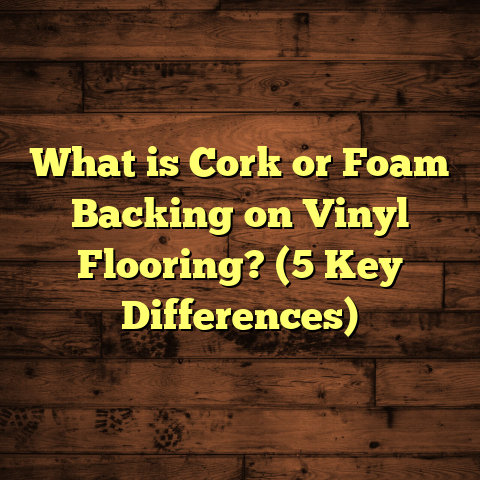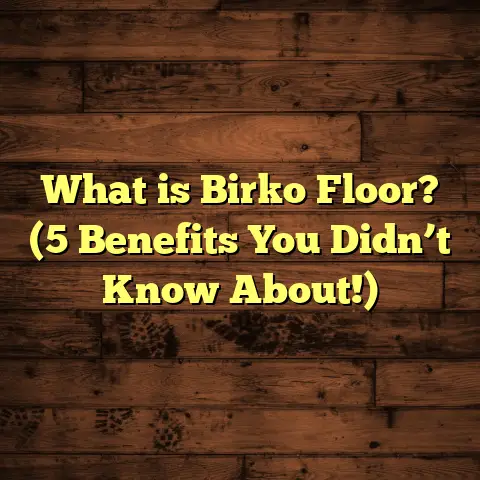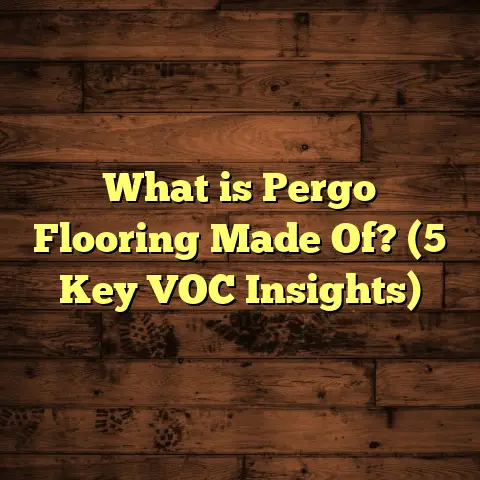What is Adura Flooring? (5 Reasons It’s the Ultimate Choice)
I still remember the moment when my flooring business hit a milestone: completing over 1,000 successful installations. Among all the materials I’ve worked with, Adura flooring has consistently stood out. It’s not just another vinyl product; it’s a material that brings together beauty, toughness, and ease in a way few others do. If you’re curious about why I recommend it so often, stick with me as I take you through everything you need to know about Adura flooring.
What Is Adura Flooring?
Adura flooring is a premium line of luxury vinyl flooring made by Mannington Mills, a trusted name in the flooring industry for over a century. Unlike basic vinyl sheets or older vinyl tiles, Adura uses advanced manufacturing techniques to create products that closely mimic the look and texture of natural materials such as hardwood, stone, and ceramic tile.
Luxury Vinyl Plank and Tile—What’s the Difference?
You might have heard the term LVP (luxury vinyl plank) or LVT (luxury vinyl tile). Adura includes both types. The planks typically imitate wood floors with long, narrow shapes, while the tiles reflect stone or ceramic options with square or rectangular shapes.
One key difference between Adura and other vinyl flooring is the core layer. Adura offers both flexible vinyl planks (similar to traditional vinyl but with enhanced styling) and rigid core planks that contain either Stone Plastic Composite (SPC) or Wood Plastic Composite (WPC). These cores add stiffness and durability that keep floors looking great even under heavy use.
How Is It Made?
Adura flooring is produced through multiple layers:
- Wear Layer: This transparent top layer protects against scratches, stains, and fading. It’s usually 12-20 mils thick in residential products and thicker in commercial lines.
- Design Layer: This is where the magic happens—the realistic image of wood grain or stone texture is printed here using high-resolution imaging.
- Core Layer: For rigid core versions, this is either SPC or WPC, offering dimensional stability and impact resistance.
- Backing Layer: Provides support and sometimes sound absorption.
This multi-layer construction ensures the floor can handle everyday wear while maintaining its look.
Waterproof? Absolutely.
One feature I personally love about Adura flooring is that many of its lines are 100% waterproof. That means spills, pet accidents, or humidity won’t warp or damage the floor like they do hardwood or laminate. This makes it an excellent choice for kitchens, bathrooms, basements, and even commercial spaces where moisture is a concern.
Sizes and Thickness
Adura planks often come in lengths between 36” to 48” with widths ranging from 6” to 9”. Thickness varies mostly between 5mm to 8mm depending on core type and collection. Thicker products offer better sound insulation and comfort underfoot but cost a bit more.
Why I Consider Adura Flooring the Ultimate Choice
Let me break down five key reasons why Adura has become my go-to recommendation for clients looking for flooring that balances style, performance, and value.
1. Durability That Holds Up Over Time
I’ve installed hardwood floors that showed scratches within months. Laminate floors that peeled after minor water exposure. Ceramic tiles that cracked under dropped items.
Adura flooring has surprised me with how well it handles daily abuse. Thanks to its commercial-grade wear layers combined with its rigid core technology, it resists dents, scratches, stains, and fading better than many alternatives.
Real Data on Wear Layer Thickness
The wear layer thickness plays a huge role in durability:
- Typical residential vinyl floors have wear layers of 6-12 mils.
- Adura’s wear layers range from 12-20 mils for residential lines.
- Commercial-grade Adura products boast up to 30 mils of wear layer for extreme durability.
This means the floor can handle heavy foot traffic in homes with kids and pets or even light commercial use without showing wear quickly.
Personal Experience With Durability
I recall a family who installed Adura in their living room and kitchen about two years ago. They have three kids under ten and two large dogs—a recipe for floor disasters. Yet when I visited recently, their floors looked almost brand new. No scratches from pet claws or dents from dropped toys. Their previous hardwood floors would have required refinishing by now.
Resistance to Water Damage
Unlike hardwood or laminate floors that swell or warp when exposed to water,
Adura’s waterproof core means it can be installed confidently in moisture-prone areas.
A client installed it in their basement—a place where water seepage had been a problem before. Months later, no signs of warping or peeling even after minor flooding incidents.
Are you thinking about installing floors in your bathroom or laundry room? This waterproof aspect alone makes Adura one of the best options available.
2. Style Options That Fit Every Taste
If you’re like me—you want your floors to not only last but also look stunning—Adura won’t disappoint.
The designs cover a wide range of aesthetics:
- Classic hardwood looks like oak, hickory, maple
- Trendy modern styles like weathered gray or bleached wood
- Stone and tile patterns like slate, travertine, or ceramic-look tiles
- Even unique textures such as wire-brushed wood
Mannington uses advanced digital imaging technology to capture realistic wood grains and stone textures down to tiny details like knots, pores, and color variations.
The Touch Test
When I first ran my hands over an Adura plank sample, the texture felt impressively close to real wood. Many vinyl products feel flat or slick; this one had subtle embossing that mimicked natural materials’ tactile features.
In my experience, this tactile realism makes a big difference in overall satisfaction with the floor because it looks and feels authentic rather than synthetic.
Matching Interior Styles
One homeowner wanted a rustic farmhouse look with lots of natural wood tones but needed something low maintenance for their busy kitchen area. We chose an Adura plank with a distressed oak finish that perfectly complemented their cabinets and island.
Another client preferred sleek contemporary floors; we went with a modern gray wood pattern from the Adura Flex collection that added character without overwhelming the space.
Whether your style is traditional or modern,
there’s almost certainly an Adura design that fits your vision.
3. Installation So Easy It Saves Time and Money
I’ve been on jobs where installing hardwood meant days of sanding, staining, finishing—the whole nine yards. Tile installations meant meticulous cutting and grouting. Compared to those,
Adura installation can be done faster with less hassle.
Most of the rigid core products come with a click-lock system where planks snap together without glue or nails. That means fewer tools are needed and cleanup is simpler.
How Installation Works
The subfloor needs to be clean, flat, and dry—pretty standard requirements. After that,
the planks just click together along edges with minimal gaps.
Because it’s waterproof,
you don’t have to worry about moisture barriers in most cases,
which further speeds up installation.
My Installation Stories
Once I installed over 500 square feet of Adura flooring in a single day alongside my crew across multiple rooms—something that would have taken at least double the time if we’d used hardwood or tile.
For DIY enthusiasts, this ease of installation means you can take on projects yourself without professional help—just be patient with cutting planks properly to fit edges and corners.
Have you ever tried installing floors yourself? If so,
you know how frustrating uneven seams or loose boards can be. With Adura’s locking system,
these issues are rare.
4. Maintenance That Fits Your Busy Life
If you’re juggling work, family, pets—who has time for complicated floor care?
Adura flooring is designed to be simple to maintain yet tough enough to resist stains and damage.
Routine cleaning involves sweeping or vacuuming dirt and dust regularly to prevent abrasion on the surface layer. Occasionally wiping with a damp mop using mild cleaners keeps the floor fresh without damaging the finish.
Stain Resistance Backed by Data
Mannington tests their wear layers against common household stains like wine, coffee, mustard, nail polish, and ink. The result? Most stains wipe off easily without leaving marks if cleaned promptly.
This stain resistance is why many clients with kids have chosen Adura for playrooms or kitchens where spills are inevitable.
Long-Term Care Tips From My Experience
I always advise clients not to use abrasive cleaning tools like steel wool or harsh chemical solvents since they can damage the wear layer over time.
Furniture pads under heavy tables or chairs prevent dents from concentrated pressure points—something I’ve seen overlooked too often by homeowners who later regret it.
Some commercial clients use special floor mats at entrances to reduce dirt tracked inside; this simple step extends floor life significantly when paired with Adura’s durability.
5. Cost Efficiency That Makes Sense Over Time
Let’s talk money—flooring isn’t cheap, and budget matters for most homeowners and businesses.
Adura flooring costs more upfront than basic vinyl sheets but less than high-end hardwood or natural stone tile installations.
What sets it apart is how its durability and low maintenance reduce replacement frequency and upkeep expenses over time,
making it cost-effective overall.
Breaking Down Costs: Materials + Labor
Material prices for Adura range roughly from $3 to $6 per square foot depending on collection and finish.
Labor costs tend to be lower than hardwood or tile because installation is quicker—on average $2-$4 per square foot depending on region and installer rates.
How I Use FloorTally for Budgeting
When planning projects,
I use FloorTally,
an online calculator that consolidates material costs,
labor estimates,
waste factors,
and even project duration into one clear estimate.
For example,
a kitchen remodel requiring 300 square feet of rigid core Adura flooring might break down like this:
| Item | Rate per Sq Ft | Total Cost |
|---|---|---|
| Material | $4.50 | $1,350 |
| Labor | $3.00 | $900 |
| Waste Factor (5%) | Included | $67 |
| Total | $2,317 |
Having this level of detail upfront helps avoid surprises mid-project and allows me to advise clients based on their budget constraints realistically.
Comparing Replacement Costs Over Time
Hardwood floors might require refinishing every 7-10 years at several hundred dollars per room plus downtime during work.
Tile grout cleaning or repairs add unexpected expenses too.
With Adura’s durability,
you’re likely looking at 15+ years before considering replacement under normal residential use,
saving money long term despite slightly higher initial investment compared to cheaper vinyl alternatives.
More Stories From Real Projects
I want to share some more real-life experiences because talking numbers is helpful but hearing stories brings things home better.
A Busy Family Home Survives Kid Chaos
A client with four children aged between 2 and 9 chose Adura rigid core flooring for their entire main floor. They needed something durable yet stylish that wouldn’t require constant upkeep amid daily spills and dirt tracked inside from school shoes and outdoor playtime.
After two years,
they reported zero scratches despite rough play,
easy cleanups after arts & crafts messes,
and no signs of water damage despite occasional spills left overnight by accident-prone kids.
They told me it was one of their best home investments because it looked great without any fussing on their part.
Commercial Office With Heavy Equipment Traffic
An office client needed flooring able to withstand rolling chairs, office equipment moves, and daily foot traffic from dozens of employees plus visitors weekly.
We installed an Adura commercial-grade SPC plank in their lobby area as well as conference rooms.
Six months later,
the floors showed no signs of denting or scratching even after heavy use,
and cleaning staff reported mopping was quick since dirt didn’t cling stubbornly like other surfaces they’d used before.
Their positive feedback reaffirmed my belief that Adura suits both residential and some commercial applications perfectly when balanced against cost constraints.
Technical Insights: What Sets Adura Apart From Competitors?
You might ask—
“Isn’t all luxury vinyl basically similar?”
Not quite. Here’s what Mannington does differently:
- Advanced Core Technology: Their SPC/WPC cores are engineered for rigidity without sacrificing comfort—some competitors use less stable cores prone to cracking.
- High-Resolution Printing: Their design layers are created with ultra-high resolution cameras capturing natural materials at microscopic detail.
- Wear Layer Innovations: Proprietary coatings enhance scratch resistance beyond typical vinyl.
- Environmental Commitment: Mannington adheres to strict sustainability practices including low VOC emissions certified products which benefit indoor air quality—a plus many overlook.
- Warranty Coverage: Residential warranties often range from 15 to 30 years depending on product line; commercial warranties vary but usually cover significant wear issues under normal conditions.
What About Installation Preparation?
One question I get asked often is:
“Do I need special subfloor prep for Adura?”
Generally speaking, your subfloor should be:
- Clean: Free of dust, debris
- Flat: Level within 3/16 inch over 10 feet
- Dry: Moisture levels within manufacturer specs (usually below 4% moisture content)
Concrete subfloors might need moisture testing before installation. If moisture levels are high,
moisture barriers may be required even though Adura itself is waterproof—to protect subfloor integrity long term.
For plywood subfloors,
check for squeaks or loose boards beforehand since they can cause movement felt through the finished floor which may affect locking mechanisms over time if ignored.
Can You Install Adura Over Existing Floors?
Another common question: “Can I install Adura right over my existing tile or vinyl floor?”
In many cases yes—as long as:
- Existing floor is firmly attached without loose tiles/planks
- Surface is flat enough (no large bumps/cracks)
- No excessive moisture issues hidden underneath
Installing over existing floors saves demolition time and disposal fees. However,
if you’re dealing with uneven surfaces,
it’s best to level subfloor first using leveling compounds before installing Adura for best results and warranty compliance.
Sound Insulation and Comfort Underfoot
While vinyl isn’t known for softness like carpet,
Adura’s WPC core options provide better cushioning than SPC due to wood-plastic composite makeup which absorbs impact more effectively.
This reduces noise from footsteps—a nice bonus if you live in an apartment or have multiple stories in your home.
Some collections also include attached underlayment layers which simplify installation further while enhancing sound reduction without extra material costs.
Environmental Impact: A Closer Look
I try to recommend materials that balance performance with environmental responsibility when possible.
Mannington Mills claims commitment to sustainability through:
- Use of recycled content in some product cores
- Low-VOC emissions certified by FloorScore® standards
- Responsible manufacturing processes reducing waste
- Programs supporting recycling old flooring materials post-removal
While luxury vinyl isn’t biodegradable like natural wood,
choosing products with these certifications helps reduce indoor air quality risks often associated with cheaper vinyl options containing harmful chemicals.
Is There Any Downsides?
I want to be honest here—no product is perfect.
Adura flooring does have some limitations worth mentioning:
- Temperature Sensitivity: Although stable under normal conditions, extreme temperature swings (like direct sunlight through large windows) can cause slight expansion/contraction requiring proper acclimation before installation.
- Not Real Wood: Some purists prefer genuine hardwood floors for resale value or aesthetic reasons.
- Heavy Furniture Concerns: While resistant overall, very heavy furniture without protective pads can leave indentations over time.
- Price Point: It’s more expensive than basic vinyl but justified by quality features discussed earlier.
Knowing these points helps set realistic expectations before choosing any flooring type—including Adura.
Wrapping Up My Experience With Adura Flooring
Over thousands of square feet installed across homes and businesses,
Adura flooring has proven itself as one of the most balanced options available today—
combining realistic design,
superior durability,
ease of installation,
simple maintenance,
and overall value for money.
It suits families with active lifestyles as well as commercial spaces needing tough yet attractive solutions without breaking budgets excessively.
If you want a floor that looks great now—and will continue looking great years from now—
Adura deserves serious consideration on your list.
Got Questions? Let’s Talk About Your Project
Maybe you’re wondering about:
- Which specific Adura collection fits your needs best?
- How much will your project cost?
- What tools can help you plan effectively?
I use FloorTally regularly—it’s a straightforward online estimator that factors local labor rates,
material prices,
waste percentages,
and project timelines into one clear budget breakdown so surprises are minimized during work phases.
Want help running numbers tailored specifically for your space?
Or need advice on prepping your subfloor?
Just ask—I’m happy to share everything I’ve learned through hands-on experience!
I hope this detailed look at Adura flooring gives you confidence whether you’re remodeling your home’s floors soon or just researching options thoughtfully. Feel free to reach out anytime if you want deeper info on any aspect—happy flooring!





